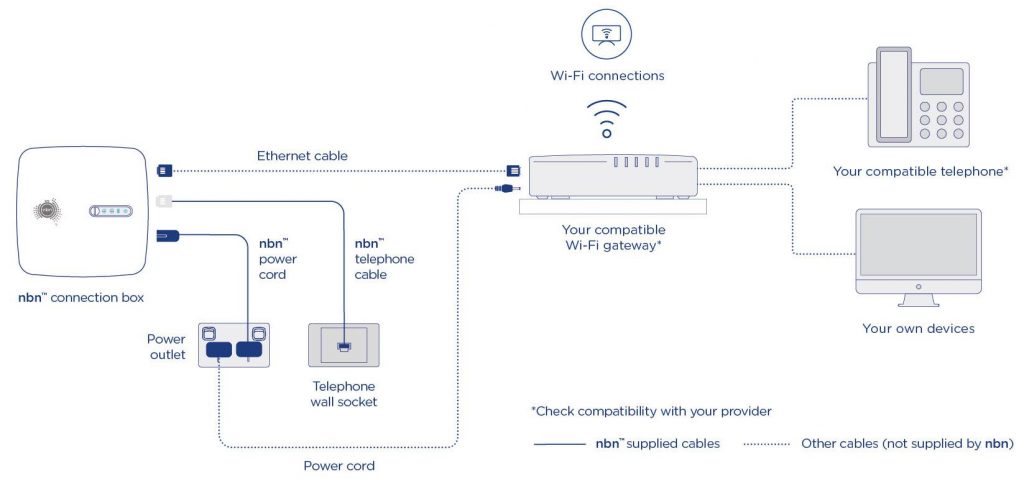Quick answer: Fibre to the Curb (FTTC) is a new access technology that will form part of the nbn™ broadband access network rollout to provide access to broadband services to Australian homes and businesses.
An nbn™ FTTC connection is used in circumstances where fibre is extended close to your premises, connecting to a small Distribution Point Unit (DPU), generally located inside a pit on the street. From here, the existing copper network is connected to the fibre to form the final nbn™ connection. To power your FTTC service with electricity and provide your connection to the nbn™ broadband access network, an FTTC nbn™ connection box will be required inside your home. In many cases, you may be eligible to perform self-installation of the nbn™ connection box.
Setting up your equipment
For assistance with setting up your equipment, download the nbn™ FTTC setup guide, or watch the installation video below.
What does the nbn™ Fibre to the Curb (FTTC) equipment look like?

FAQs about FTTC
What speeds can I expect for an FTTC service?
FTTC services can deliver a range of speeds to Distribution Point Unit (DPU).
The actual speed you will experience depends on a number of factors including; how far your home is located from the DPU, the maximum line speed available, your home’s internal cabling, local conditions such as internet traffic, your hardware and software, the data source or destination, software, the plan you choose, the performance of your modem, Wi-Fi, and other devices in your home.
We’ll run speed tests to confirm your maximum line speed when your nbn™ service is working and tell you if a different nbn™ plan is more suitable for your home. If you select a plan that you later find does not work for you (or your home), you can change your plan anytime at no charge. We’ll always recommend the right plan for you, even if that means you pay less.
Read more about Internet Speeds
What do I need to consider before I get an FTTC connection?
Before moving to an nbn™ FTTC connection, you should check the following:
- Do you have any existing medical, fire, or security alarms? Check with your alarm provider to ensure compatibility when moving to the nbn™ access network. You should also register your device with NBN Co.
- Do you have an existing phone service? Make sure that your phone is compatible with the nbn™ access network.
- Do you have other ADSL services, for example, a phone, alarm or fax machine? You may need to re-route or disconnect these before moving to a plan over the nbn™ access network.
- Do you have power sockets near your telephone socket? You will need two power sockets for your FTTC connection.
- If you do need to re-route, disconnect or add a new power socket, it could be worth talking to a registered cabler to ensure your in-home cabling is up to scratch before you get connected.
Learn more about device compatibility
What equipment will I need for my FTTC connection?
To use your FTTC service, you will need an FTTC nbn™ connection device and your Wi-Fi gateway. The nbn™ connection device will be provided to you so you can connect to the nbn™ broadband access network, however, this will remain the property of the NBN Co and should not be removed from the premises.
An nbn-ready gateway will also be needed. If you have purchased a modem from Australia Broadband, it will compatible with all nbn™ technology types (including FTTC) and will be pre-configured with our Australia Broadband internet settings.
If you are using a BYO modem, it must be nbn™ compatible for it to work over the nbn™ access network. Visit Can I bring my own modem with Australia Broadband? for more information.
Will nbn™ need to do any work inside my home to enable my FTTC connection?
In many situations, getting your FTTC service connected can be as simple as you plugging in the nbn™ connection device and your Wi-Fi gateway. If you are eligible for this self-installation option, Australia Broadband will arrange for the NBN Co to send you the NBN Co equipment needed so you can complete the installation yourself. In other cases, NBN Co may need to make an appointment to undertake work inside your premises to make sure your FTTC connection is complete.
What kind of speeds should I expect on my FTTC connection?
The nbn™ FTTC network is designed to offer access (for most premises) to a range of internet speeds.
Your actual speeds will be affected by many factors including; your cabling throughout the building, how your provider configures their network and manages traffic (particularly during peak periods when more people are online), equipment quality, software, signal quality, the nbn™ powered plan you choose, the performance of your modem, Wi-Fi, and other devices in your premises.
Read more about Internet Speeds
I have a medical, fire and/or security alarm in my designated FTTC premises. Will my alarms be compatible with the nbn™ FTTC network?
Some of your existing devices may not be compatible with the nbn™ access network. This may mean it will stop working once you switch to FTTC. It’s important to talk to your device provider for advice and to find out if your device or service will work on the nbn™ access network, and what alternatives may be available.
Make sure you register your medical, fire and/or security alarm device with NBN Co. Registering helps the NBN Co identify premises where support may be needed to help minimise a break in service.
You can register via 1800 227 300 or by visiting www.nbn.com.au/compatibility
Will devices connected to the nbn™ FTTC network work in a power outage?
Equipment connected over the nbn™ FTTC network will not work during a power blackout.

